In this tutorial, we will learn how to authenticate users with their phone numbers using Firebase's authentication module in a Non-Expo React Native application.
Firebase
Firebase is a platform developed by Google for creating mobile and web applications. It was originally an independent company founded in 2011. In 2014, Google acquired the platform and it is now their flagship offering for app development.
Authentication Module
Firebase's authentication module provides backend services and SDKs to authenticate users in your app. It supports authentication using passwords, phone numbers, popular identity providers like Google, Facebook and Twitter, and more.
The native Firebase SDKs ensure that a user's authentication state between app sessions is persisted. The user can clear their authentication state by clearing the app's data/cache.
Prerequisites
The basics of React and React Native will not be covered in this tutorial. If you are not comfortable with the basics, this is a helpful tutorial.
Overview
We'll be going through these steps in this article:
- Development environment.
- Cloning the starter code.
- Setting up the Firebase project.
- Setting up Firebase Authentication.
- Phone Number.
- Verification code.
- Authenticated screen.
- Signout.
- Test phone numbers.
- Recap.
Development environment
IMPORTANT - We will not be using Expo in our project.
You can follow this documentation to set up the environment and create a new React app.
Make sure you're following the React Native CLI Quickstart, not the Expo CLI Quickstart.
Cloning the starter code
To focus more on the authentication module, you can clone the starter code from this repository on GitHub. Follow the Repository's README for instructions.
For the final code, you can look at this GitHub Repository.
This will be the folder structure of the application.
I've set up 3 screens in the screens/ directory:
PhoneNumber.js: Screen to enter the phone number.
VerifyCode.js: Screen to enter the one-time verification code.
Authenticated.js: Screen that the user can see only if he is logged in.
In the App.js, the PhoneNumber screen is exported. As we write the code for authentication, we will display various screens at various stages.
Setting up the Firebase project
Head to the Firebase console and sign in to your account.
Create a new project.
Once you create a new project, you'll see the dashboard.
Now, click on the Android icon to add an Android app to the Firebase project.
You will need the package name of the application to register the application. You can find the package name in the AndroidManifest.xml which is located in android/app/src/main/.
You will also need the Debug signing certificate SHA-1. You can get that by running the following command in the project directory.
cd android && ./gradlew signingReport
This will generate the signing certificate of the application.
You will get an output like this:
Task :app:signingReport
Variant: debugUnitTest
Config: debug
Store: C:\Users\Mohan\.android\debug.keystore
Alias: AndroidDebugKey
MD5: 5F:BB:9E:98:5E:E7:E6:29:19:28:61:4F:42:B9:74:AB
SHA1: 9E:61:75:0E:5C:F4:EB:B4:EB:9D:B3:13:5F:50:D6:AB:2E:4E:12:0D
SHA-256: 6C:BB:49:66:18:B9:7F:74:49:B5:56:D0:24:43:6A:1B:41:91:97:A3:2E:7C:4A:6E:59:40:8F:5C:74:6F:CC:93
Valid until: Friday, December 23, 2050
Make sure you are copying the
SHA1fromTask :app:signingReportand not from any other Task.
Copy the SHA1 value and paste it into the Firebase console.
Now, proceed to the next step, you can download the google-services.json file. You should place this file in the android/app directory.
This file contains configurations that'll enable your application to access firebase services.
After adding the file, proceed to the next step. It will ask you to add some configurations to the build.gradle files.
First, add the google-services plugin as a dependency inside of your android/build.gradle file:
buildscript {
dependencies {
// ... other dependencies
classpath 'com.google.gms:google-services:4.3.3'
}
}
Then, execute the plugin by adding the following to your android/app/build.gradle file:
apply plugin: 'com.android.application'
apply plugin: 'com.google.gms.google-services'
You need to perform some additional steps to configure Firebase for iOS. Follow this documentation to set it up.
Finally, we should install the @react-native-firebase/app package in our app to complete the set up for Firebase.
npm install @react-native-firebase/app
Setting up Firebase Authentication
Head over to the Authentication section in the dashboard and click on the Get Started button. This will enable the authentication module in your project.
Next, you should enable phone authentication in the sign-in methods. Once you've enabled it, press save.
Firebase must be able to verify that the requests are coming from your app.
There are two ways to accomplish this:
- SafetyNet: If the user has a device with Google Play Services installed, then Firebase can verify whether the request is legitimate.
In the Google Cloud console, enable the Android Device Verification API for your project. The default Firebase API Key will be used and needs to be permitted to access the DeviceCheck API.
- reCAPTCHA: If SafetyNet cannot be used, Firebase does a reCAPTCHA verification. The reCAPTCHA challenge can often be completed without the user having to solve anything.
Now, let's head to the application and install the auth module.
Let's install the @react-native-firebase/auth package in our app.
npm install @react-native-firebase/auth
Let's declare the dependency for the authentication module in the android/app/build.gradle file using the Firebase Android BoM
dependencies {
// Add these lines
implementation platform('com.google.firebase:firebase-bom:26.3.0')
implementation 'com.google.firebase:firebase-auth'
}
When reCAPTCHA is used for device verification, the application will open the browser for the reCAPTCHA test. So, we should also add implementation "androidx.browser:browser:1.2.0" in the android/app/build.gradle file.
dependencies {
implementation platform('com.google.firebase:firebase-bom:26.3.0')
implementation 'com.google.firebase:firebase-auth'
// Add this line
implementation "androidx.browser:browser:1.2.0
}
With this, the firebase authentication module is set up in our application.
Phone Number
In App.js, let's import the auth module from Firebase.
import auth from '@react-native-firebase/auth';
We should use the signInWithPhoneNumber method in the auth module. It accepts a phone number in the form of a string as its argument. It is an async function, thus it returns a Promise.
The phone number should contain the country code in it.
auth().signInWithPhoneNumber('+91 1234567890');
This will trigger the Firebase servers to send a verification code to the given phone number.
The signInWithPhoneNumber method returns an object with a confirmation method that is used to verify the one-time code sent to the number.
Let's create a state using the useState hook to hold the confirmation method.
import React, { useState } from 'react';
const [confirm, setConfirm] = useState(null);
Now, let's write a function that accepts a phone number as an argument and calls the signInWithPhoneNumber function with the given phone number.
We should use async/await to wait for the promise to be resolved. If the promise is resolved, let's set the returned confirmation method to the confirm state using the setConfirm method.
async function signIn(phoneNumber) {
try {
const confirmation = await auth().signInWithPhoneNumber(phoneNumber);
setConfirm(confirmation);
} catch (error) {
alert(error);
}
}
We should pass this function to the PhoneNumber screen as a prop, and call this function when the user presses the button.
return <PhoneNumber onSubmit={signIn} />;
In PhoneNumber.js, I've already set up a state that holds the phone number from the input. Let's call the function that we passed and send the phone number as the argument.
To call a function when the user presses a button, you should pass the function to the onPress property of the button.
<Button title="Phone Number Sign In" onPress={() => props.onSubmit(phoneNumber)} />
Now, when the user presses the button, the signInWithPhoneNumber method from the auth module is called and it will trigger the Firebase servers to send a verification code to the given phone number. It will also return a method that should be used to confirm the verification code.
Verification Code
When the confirmation method is available, we should display the VerifyCode screen instead of the PhoneNumber screen.
if (confirm) return <VerifyCode />;
return <PhoneNumber onSubmit={signIn} />;
Now that we have displayed the screen, let's write a function to confirm the verification code.
The confirm method is an async method. If the verification code is correct, the promise will be resolved. If not, it'll be rejected.
We should also make sure to clear the confirm method from the state once it serves its purpose.
async function confirmVerificationCode(code) {
try {
await confirm.confirm(code);
setConfrim(null);
} catch (error) {
alert('Invalid code');
}
}
Let's pass this function to the VerifyCode screen as a prop, and call this function when the user presses the confirm button.
if (confirm) return <VerifyCode onSubmit={confirmVerificationCode} />;
return <PhoneNumber onSubmit={signIn} />;
In VerifyCode.js, I've already set up a state that holds the verification code from the input. Let's call the function that we passed and pass the verification code as the argument.
<Button title="Confirm OTP" onPress={() => props.onSubmit(code)} />
Now, when the user presses the button, the confirm method is called and that will verify whether the code is correct or not. The user will be authenticated into the app if the verification code is correct. If not, we will display an error message to the user.
Authenticated screen
The onAuthStateChanged event will be triggered whenever the authentication state of the user changes inside the application.
You can set an event handler for this listener. This handler will receive the user object. If the user object is null, it means the user is signed-out, otherwise, they are signed-in.
You can access the current authenticated user's details using auth().currentUser from anywhere in the application.
To learn more about the user object, refer to this documentation.
Let's create a state to track whether the user is authenticated or not. We should set the default value to false.
const [authenticated, setAutheticated] = useState(false);
Let's set the authenticated state to true if the user object is not null in the onAuthStateChanged handler.
auth().onAuthStateChanged((user) => {
if(user) {
setAutheticated(true);
}
})
If the user is authenticated, we should display the Authenticated screen.
if (authenticated) return <Autheticated />;
if (confirm) return <OTPScreen onSubmit={confirmOTP} />;
return <PhoneNumber onSubmit={signIn} />;
Signout
We should use the signOut method in the auth module to sign out a user from the application.
Let's import the auth module in Authenticated.js.
import auth from '@react-native-firebase/auth';
Let's call the signOut method when the user presses the signout button.
<Button title="Signout" onPress={() => auth().signOut()} />
Now, when the user presses the button, the auth module will sign out the user from the application. This will trigger the onAuthStateChanged listener. The handler will receive null instead of the user object.
We should set the authenticated state to false if we receive null.
auth().onAuthStateChanged((user) => {
if(user) {
setAuthenticated(true);
} else {
setAuthenticated(false);
}
})
Test phone numbers
Firebase provides support for testing phone numbers.
In the Firebase Console, click on the "Phone numbers for testing" dropdown in the "Phone" authentication provider.
Enter a new phone number and a test code.
Once added, the number can be used with the signInWithPhoneNumber method. The firebase server will not send a verification code to a test number. You should enter the test code that you specified here in the application to sign-in.
Result
Here is the sign-in flow if the Device Verification API works properly.
If the Device Verification API is not enabled, or if SafetyNet can't be reached, the auth module will use a reCAPTCHA to verify the request.
Let's Recap
We set up our development environment and created a React Native app.
We created a Firebase project.
We set up the authentication module and enabled phone number authentication in our project.
We enabled the Device Verification API in the Google Cloud Console for our project.
We cloned the starter code.
We added the dependencies to the
build.gradlefiles.We used the
authmodule to send a verification code to the given phone number.We added a method to confirm the verification code.
We created a state to track the authentication state of the user and used the
onAuthStateChangedhandler to update the state.We used the
authmodule to sign the user out from the application from the Authenticated screen.We learned how to add Test numbers from the Firebase console.
Congratulations, 🥳 You did it.
Thanks for reading!



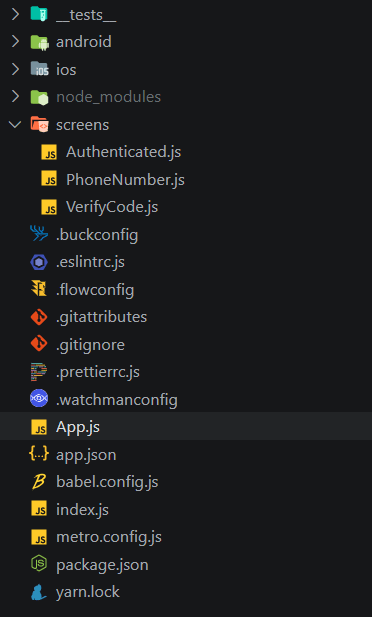
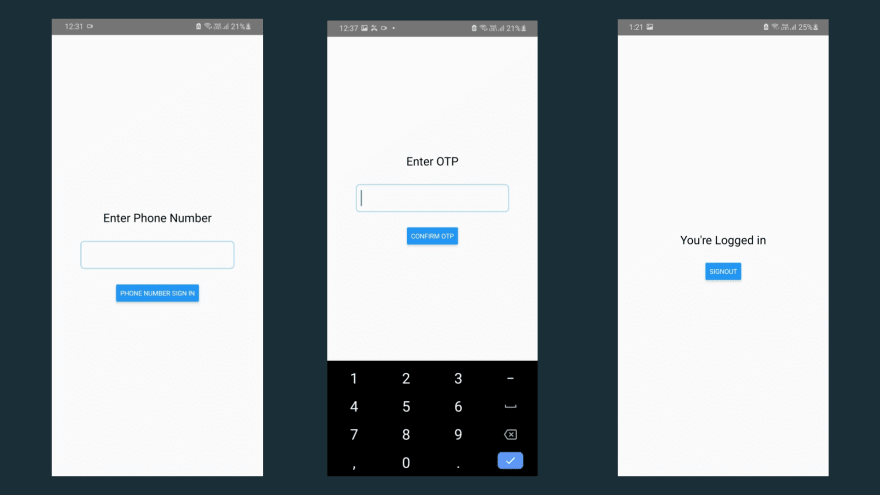
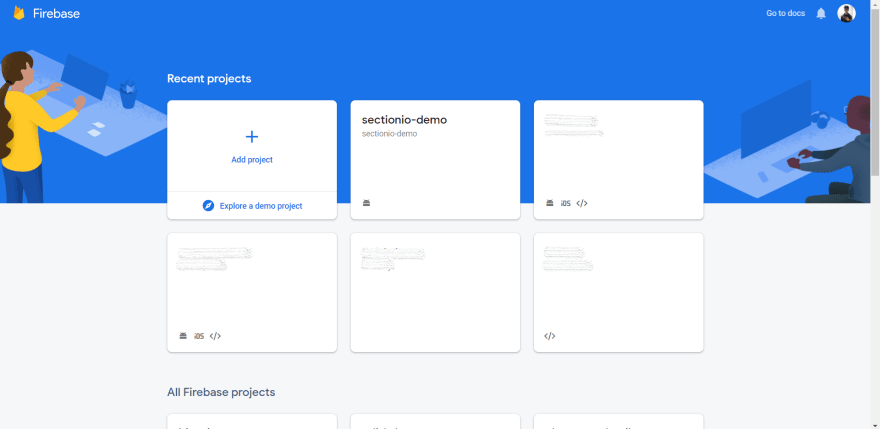
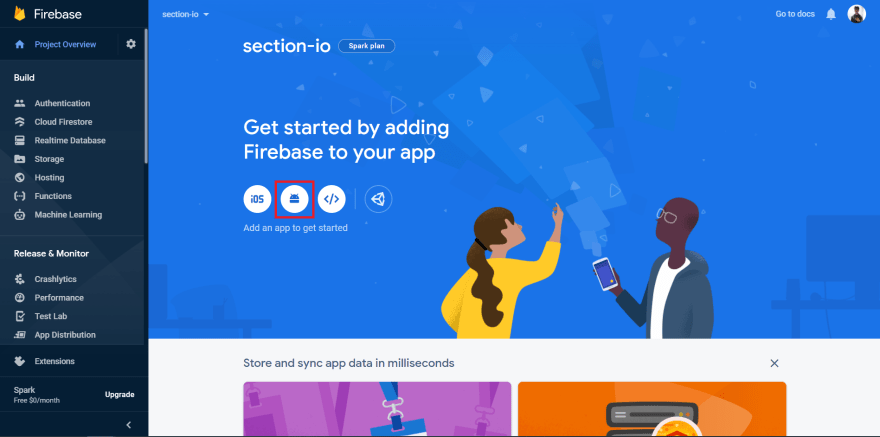
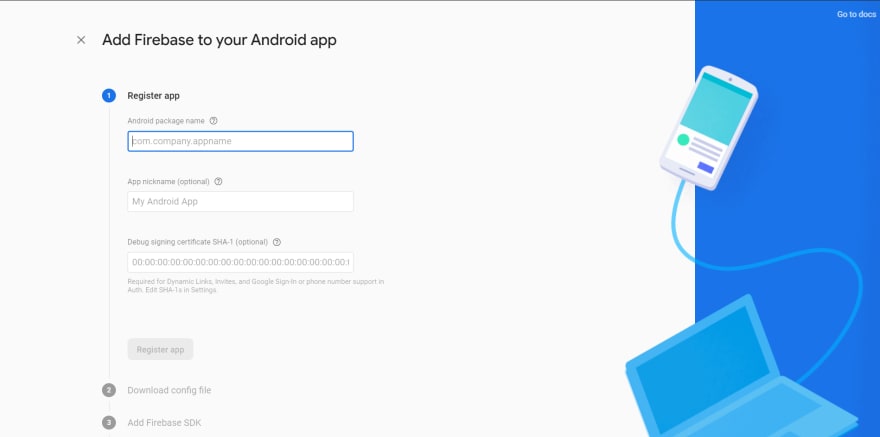
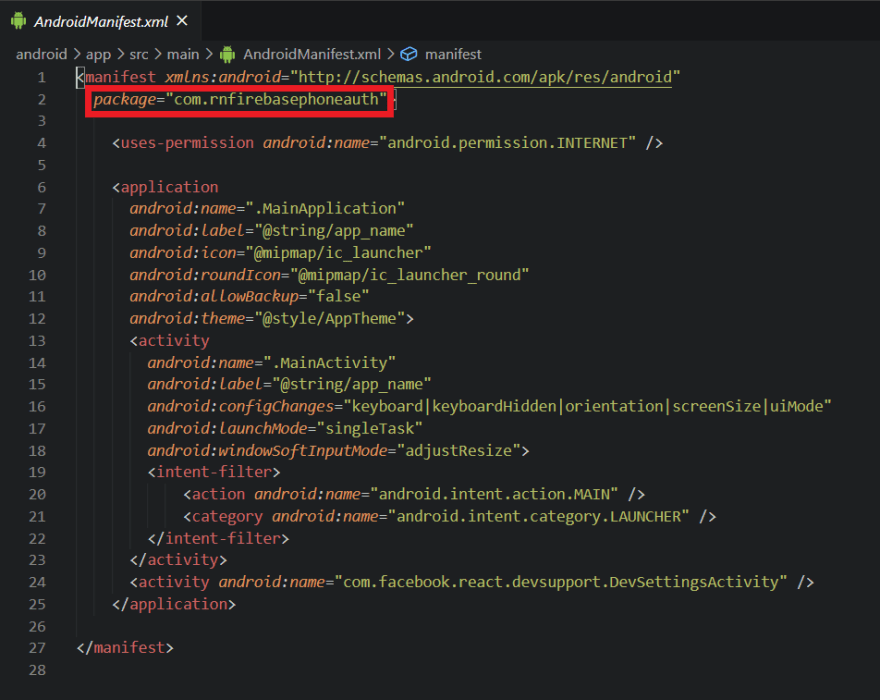
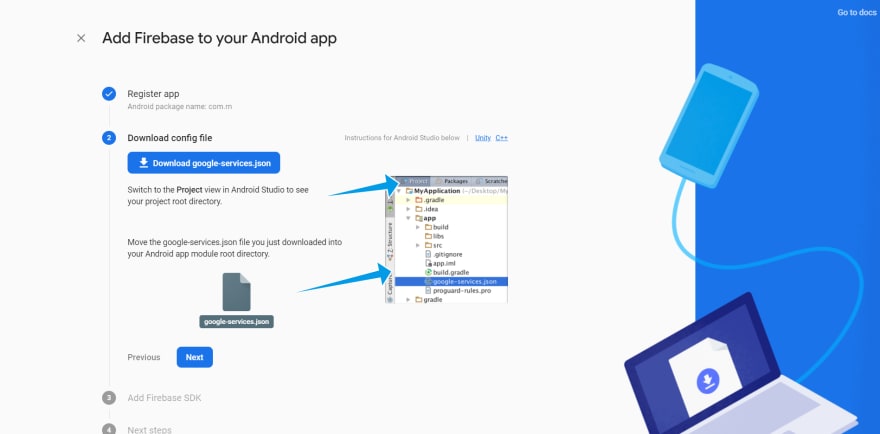
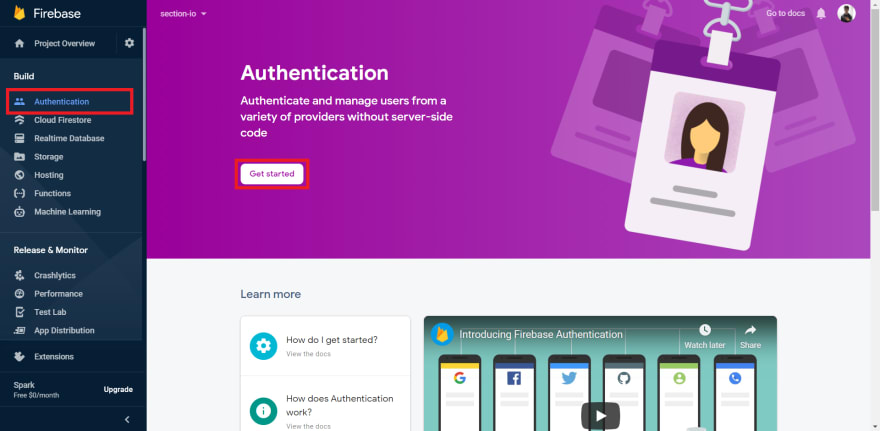
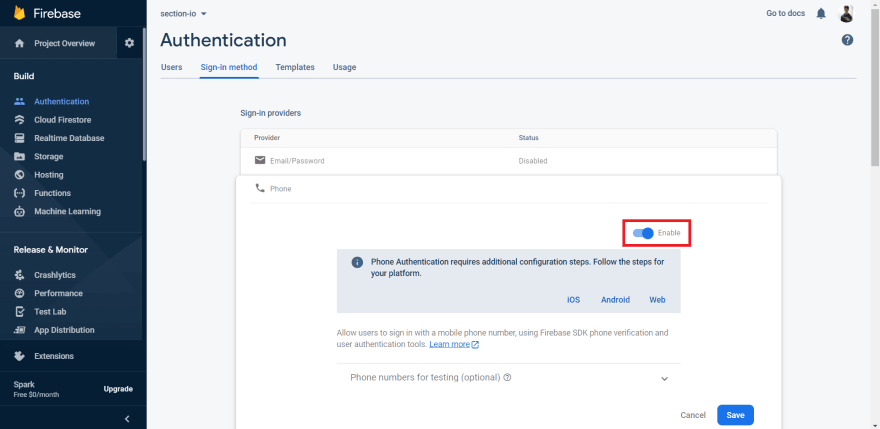
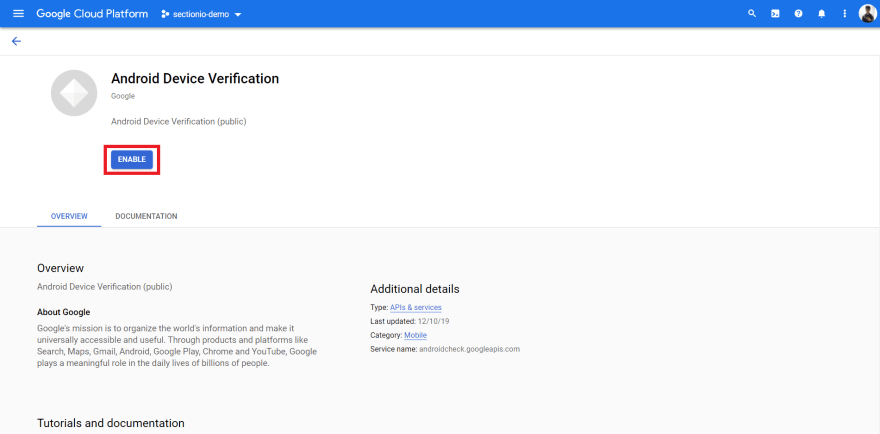

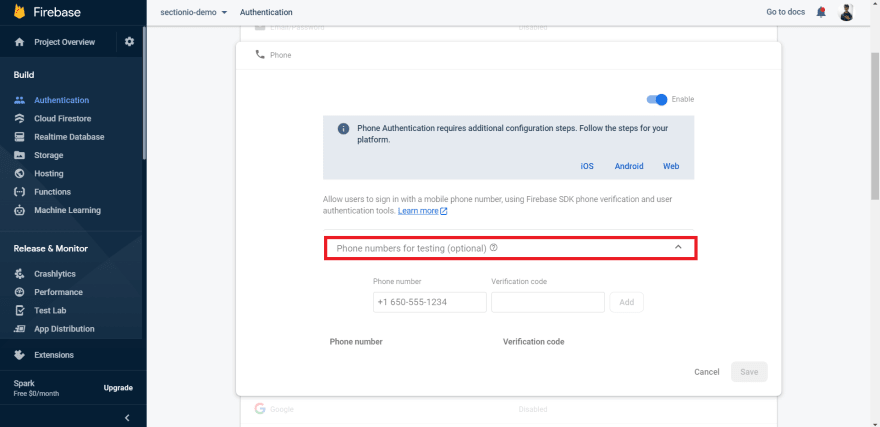
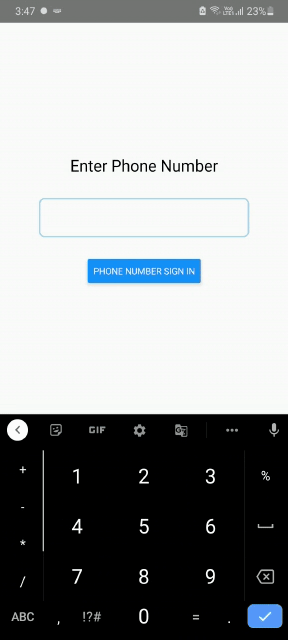






Top comments (0)